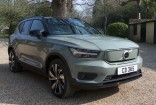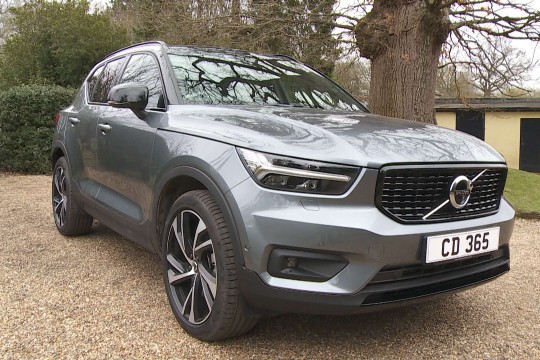There are three flavours of EX40 on offer. Most customers will opt for the 69kWh 'Single Motor' version, which was once (in this car's original XC40 Pure Electric form) front-driven, but the Swedish maker's now moved the e-motor to the rear axle and slightly uprated its output to 238hp. Without any real impact on performance - rest to 62mph is dispatched in 7.3s on the way to the 112mph top speed that all Volvos these days share. EV driving range is WLTP-rated at up to 296 miles. To get the claimed mileage, you'll need to engage what the Swedish maker calls 'One Pedal Drive', selectable from the 'Driving' menu provided on this centre-dash screen. This dramatically increases the regenerative braking effect when you come off the throttle, to the point where, as advertised, the brake pedal will hardly ever be needed. There's also a 'Single Motor 'Extended Range' 78kWh mid-level rear-driven model, which has 252hp and uses a larger 78kWh battery providing for a 345 mile range.
The faster EX40 alternative is the 'Twin Motor' AWD variant we tried, which uses a larger 82kWh battery pack and twin electric motor set-up that has now adopted different front and rear e-motors, with 150hp and 258hp respectively. These provide for a prodigious 408hp total power output figure in the standard Twin Motor model, but if for some reason that's not enough, you can boost it further to 442hp with an optional 'Performance' software upgrade. Even with a standard Twin Motor EX40 variant, performance is startling, a massive 670Nm of torque (at which point the main motor is spinning at a heady 14,000rpm), catapulting the car to 62mph in just 4.7s.
In 'Single Motor' form, an EX40 is around 350kgs heavier than the equivalent XC40 B3 mild hybrid model and you certainly feel that at speed through tight corners. Ride quality though is pleasantly supple and better than most similarly-sized EV rivals, aided by this EV variant's switch to a softer 'Touring' suspension set-up. That doesn't deliver a very sharp feel through the bends, but the distinctly modest level of feedback through the electric steering rack doesn't encourage you to seek that anyway, even if you use the centre screen option that switches the steering to its firmer setting.
It's worth noting that the EV figures we mentioned earlier are a little down on those of an identically-engineered Polestar 2. To get the claimed mileage, you'll need to engage what the Swedish maker calls 'One Pedal Drive', selectable from the 'Driving' menu provided on the centre-dash screen. This dramatically increases the regenerative braking effect when you come off the throttle, to the point where, as advertised, the brake pedal will hardly ever be needed. Other than that, no driving modes are provided, though there is a screen button to firm up the steering.


.jpg)
.jpg)
.jpg)
.jpg)
.jpg)
.jpg)
.jpg)
.jpg)
.jpg)
.jpg)
.jpg)
.jpg)
.jpg)
.jpg)
.jpg)
.jpg)
.jpg)
.jpg)
.jpg)
.jpg)
.jpg)


.jpg)
.jpg)
.jpg)
.jpg)
.jpg)
.jpg)
.jpg)
.jpg)
.jpg)
.jpg)
.jpg)
.jpg)
.jpg)
.jpg)
.jpg)
.jpg)
.jpg)
.jpg)
.jpg)
.jpg)
.jpg)